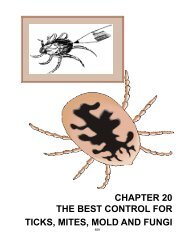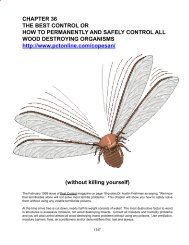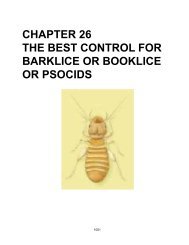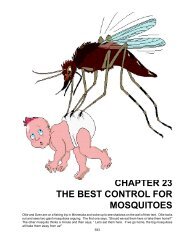chapter 16 the best control for human lice and scabies
chapter 16 the best control for human lice and scabies
chapter 16 the best control for human lice and scabies
You also want an ePaper? Increase the reach of your titles
YUMPU automatically turns print PDFs into web optimized ePapers that Google loves.
major aggressive infestations are referred to as Keratotic Scabies, Crusted Scabies or Norwegian Scabies.<br />
Infected patients have thickened, crusty areas all over <strong>the</strong>ir bodies, including <strong>the</strong>ir scalps. Their skin appears<br />
scaly <strong>and</strong> <strong>the</strong>ir fingernails may become thick <strong>and</strong> horny. Most patients who become so heavily infected do not<br />
scratch, have weakened immune systems due to diseases, e.g, aids, leukemia, diabetes <strong>and</strong>/or are exposed to<br />
pesticides or medicines such as those given in chemo<strong>the</strong>rapy or after <strong>the</strong>y have received a transplanted organ,<br />
drink heavily <strong>and</strong>/or live in institutions, e.g., nursing homes, hospitals, residential facilities, prisons <strong>and</strong> o<strong>the</strong>r<br />
communities; <strong>the</strong>y may be debilitated <strong>and</strong>/or malnourished or elderly, mentally retarded, physically infirm <strong>and</strong>/<br />
or have o<strong>the</strong>r diseases that affect <strong>the</strong>ir skin’s ability to feel sensation.<br />
Testing - According to <strong>the</strong> American Academy of Dermatology <strong>the</strong> most common test involves applying a drop<br />
of sterile mineral oil to <strong>the</strong> suspected lesion. The site is <strong>the</strong>n scraped with a scalpel <strong>and</strong> <strong>the</strong> scrapings are<br />
transferred to a slide. Under a microscope, <strong>the</strong> doctor should be able to find <strong>scabies</strong> mites, <strong>the</strong>ir eggs <strong>and</strong>/or<br />
feces. Ano<strong>the</strong>r option is an ink test, in which <strong>the</strong> doctor applies a blue or black felt-tipped pen to <strong>the</strong> suspected<br />
areas. Then <strong>the</strong> skin is cleaned. Mite burrows can be revealed if <strong>the</strong> ink sinks into <strong>the</strong>m.<br />
Spot Treatment(s) - Take ½ oz. of Safe Solutions Enzyme Cleaner or ½ oz. of Lice R Gone ® <strong>and</strong> dilute in a cup<br />
of water. Put a (1” x 1”) gauze pad over <strong>the</strong> infested area(s) <strong>and</strong> keep <strong>the</strong> pad(s) moist (using an eye dropper)<br />
<strong>for</strong> at least one hour (or spray as needed). Use this technique on <strong>the</strong> infested area(s) daily <strong>for</strong> at least 2 weeks<br />
<strong>and</strong>/or as needed. You can also make a mix of 1 oz. enzyme cleaner per quart (32 oz.) of water <strong>and</strong> spray as<br />
needed.<br />
A paste made from two herbs, neem (Azadirachta indica) <strong>and</strong> tumeric (Curcuma longa) applied to <strong>the</strong> infected<br />
area(s) daily <strong>for</strong> 2 weeks (or as needed) will help heal <strong>scabies</strong>.<br />
Bathing - If you decide to use Lice R Gone ® or diluted Safe Solutions Enzyme Cleaner, use 2- 6 oz. per bath<br />
(You can also add ½ cup of borax or kosher salt <strong>and</strong> ½ cup of vinegar to your bath water.), add body temperature<br />
water (not hot) up to your hips <strong>and</strong> soak <strong>for</strong> at least 30 minutes. Use a wash cloth <strong>and</strong> keep <strong>the</strong> entire body wet.<br />
Keep out of eyes. Ba<strong>the</strong> in solution at least once a week <strong>for</strong> 2 - 3 weeks <strong>and</strong>/or as needed.<br />
SEVERAL “LAST” TOXIC CONTROL CAUTIONS/WARNINGS<br />
Resistant <strong>lice</strong> infestations are so common now that people are using <strong>the</strong>se dangerous over-<strong>the</strong>-counter poison<br />
shampoos <strong>for</strong> far longer periods or more frequently than <strong>the</strong>y should <strong>and</strong> if you think this is “bad” - on 11/1/96<br />
Warner Lambert manufacturer of <strong>the</strong> product Nix ® received FDA approval to market this poison as a prophylactic<br />
agent! Lice are already resistant to permethrin poison as reported in <strong>the</strong> U. S., Canada, <strong>the</strong> U.K., Israel <strong>and</strong><br />
Czechoslovakia, but children are not resistant to <strong>the</strong>se poisons. In <strong>the</strong> Winter/Spring/1997 issue of NPA’s<br />
Progress a mo<strong>the</strong>r who lost her son to leukemia after she repeatedly shampooed his hair to “prevent” <strong>lice</strong> found<br />
an issue of Chemical Engineering News (in order to find a correlation with Nix ® <strong>and</strong> Lindane) which had an<br />
article on <strong>the</strong> phasing out of chlorinated hydrocarbons. It included a specific chart which included a listing of<br />
endocrine disrupters. Syn<strong>the</strong>tic pyrethroids such as permethrin found in Nix ® were included in <strong>the</strong> chart with<br />
different herbicides, fungicides <strong>and</strong> pesticide poisons. They were all in <strong>the</strong> same category in terms of <strong>the</strong><br />
health effects - <strong>and</strong> <strong>the</strong> negative effects were many!<br />
“Treating” actual <strong>lice</strong> or <strong>scabies</strong> infestations with lindane can cause many adverse health problems including<br />
permanent seizure disorders <strong>and</strong> severe mental retardation. In February, 1993, Barre National, a generic lindane<br />
lotion manufacturer, settled <strong>the</strong> Santiago family’s Massachusetts lawsuit <strong>for</strong> severe brain injury. Previously <strong>the</strong><br />
pharmacy that sold <strong>the</strong> poison had settled with <strong>the</strong> family. In 1986, a pediatrician prescribed 2 ounces of Kwell<br />
(1% lindane) lotion to treat Jose Santiago’s <strong>scabies</strong> infestation. (The Kwell br<strong>and</strong> product has been withdrawn<br />
from <strong>the</strong> market.) The pharmacist sold Mrs. Santiago 4 ounces of a generic br<strong>and</strong>. Mrs. Santiago applied it to<br />
her baby nightly <strong>for</strong> a week. Today, 9-year-old Jose has a permanent seizure disorder <strong>and</strong> has only developed<br />
to <strong>the</strong> level of a 3-year-old. Lindane is an organochlorine pesticide poison in <strong>the</strong> same family as <strong>the</strong> banned<br />
carcinogens DDT <strong>and</strong> chlordane. Lindane has been linked to serious brain injury <strong>and</strong> seizure disorders, <strong>and</strong> it<br />
is suspected of causing cancer, birth defects, fetal toxicity, developmental neurotoxicity, blood dyscrasias <strong>and</strong><br />
reproductive disorders. In 1983, Public Citizen’s Health Resource Group petitioned <strong>the</strong> FDA to ban all medicines<br />
containing lindane, as more seizures <strong>and</strong> brain damage kept being reported.<br />
The National Pediculosis Association (NPA) had an article in <strong>the</strong> spring 1994 NPA’s Progress written by a school<br />
nurse, Judy Magee. In 1992 she conducted a survey of 27 families with 119 children. She found: (1) 23% of<br />
802









